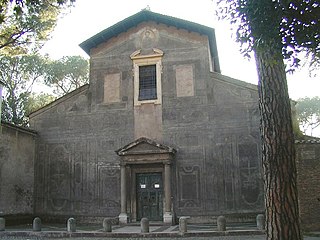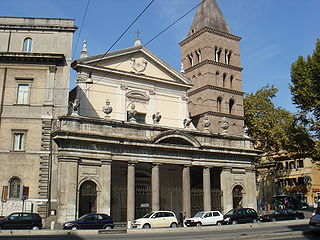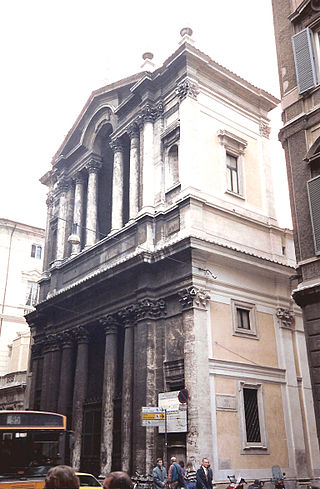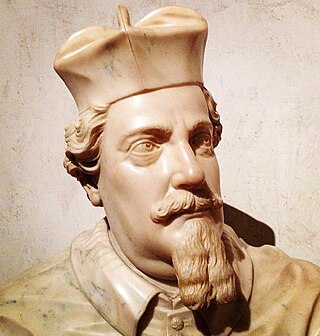
San Saba is an ancient basilica church in Rome, Italy. It lies on the so-called Piccolo Aventino, which is an area close to the ancient Aurelian Walls next to the Aventine Hill and Caelian Hill.

Agathaof Sicily is a Christian saint. Her feast is on 5 February. Agatha was born in Catania, part of the Roman Province of Sicily, and was martyred c. 251. She is one of several virgin martyrs who are commemorated by name in the Canon of the Mass.

The Church of the Gesù is the mother church of the Society of Jesus (Jesuits), a Catholic religious order. Officially named Chiesa del Santissimo Nome di Gesù all'Argentina, its façade is "the first truly baroque façade", introducing the baroque style into architecture. The church served as a model for innumerable Jesuit churches all over the world, especially in the Americas. Its paintings in the nave, crossing, and side chapels became models for Jesuit churches throughout Italy and Europe, as well as those of other orders. The Church of the Gesù is located in the Piazza del Gesù in Rome.

The House of Barberini is a family of the Italian nobility that rose to prominence in the 17th century Rome. Their influence peaked with the election of Cardinal Maffeo Barberini to the papal throne in 1623, as Pope Urban VIII. Their urban palace, the Palazzo Barberini, completed in 1633 by Bernini, today houses Italy's Galleria Nazionale d'Arte Antica.

There are more than 900 churches in Rome, which makes it the city with the largest number of churches in the world. Almost all of these are Catholic.

Santi Quattro Coronati is an ancient basilica in Rome, Italy. The church dates back to the fourth or fifth century, and is devoted to four anonymous saints and martyrs. The complex of the basilica with its two courtyards, the fortified Cardinal Palace with the Saint Silvester Chapel, and the monastery with its cosmatesque cloister is built in a silent and green part of Rome, between the Colosseum and San Giovanni in Laterano, in an out-of-time setting.

Santa Cecilia in Trastevere is a 5th-century church in Rome, Italy, in the Trastevere rione, devoted to the Roman martyr Saint Cecilia.

Santi Nereo ed Achilleo is a fourth-century basilica church in Rome, Italy, located in via delle Terme di Caracalla in the rione Celio facing the main entrance to the Baths of Caracalla. It has been the titular church of Cardinal Celestino Aós Braco since 28 November 2020.

Francesco Barberini was an Italian Catholic Cardinal. The nephew of Pope Urban VIII, he benefited immensely from the nepotism practiced by his uncle. He was given various roles within the Vatican administration but his personal cultural interests, particularly in literature and the arts, meant that he became a highly significant patron. His secretary was the antiquarian Cassiano dal Pozzo who was also a discerning patron of the arts. Francesco was the elder brother of Cardinal Antonio Barberini and Taddeo Barberini who became Prince of Palestrina.

Santa Francesca Romana, previously known as Santa Maria Nova, is a Roman Catholic church situated next to the Roman Forum in the rione Campitelli in Rome, Italy.

Sant'Angelo in Pescheria or in Piscaria is a church in Rome. It dates from the 8th century. "In Pescheria" refers to its location close to the fish market built in the ruins of the ancient Porticus Octaviae.

San Crisogono is a church in Rome dedicated to the martyr Saint Chrysogonus. It was one of the tituli, the first parish churches of Rome, and was probably built in the 4th century under Pope Sylvester I (314–335).

Santa Maria in Via Lata is a church on the Via del Corso, in Rome, Italy. It stands diagonal from the church of San Marcello al Corso.

San Cesareo in Palatio or San Caesareo de Appia is a titular church in Rome, near the beginning of the Appian Way. It is dedicated to Saint Caesarius of Terracina, a 2nd-century deacon and martyr.

San Paolo Maggiore is a basilica church in Naples, southern Italy, and the burial place of Saint Cajetan, founder of the Theatines. It is located on Piazza Gaetano, about 1-2 blocks north of Via dei Tribunali.

The former Roman Catholic Diocese of Sant'Agata de' Goti, in the Province of Benevento, Campania, southern Italy, was a suffragan of the Archdiocese of Benevento from its creation in 969. In 1986, it was merged into the Diocese of Cerreto Sannita-Telese-Sant'Agata de' Goti, which continued as a suffragan of the Archdiocese of Benevento.

The Ancient Royal and Eminent Basilica Collegiate of Our Lady of the Alms, better known as Basilica della Colleggiata, is a church in Catania, Sicily, southern Italy. Finished in 1794, it is an example of Sicilian Baroque.

Giulio Gabrielli was an Italian Catholic cardinal. He is sometimes referred to as Giulio Gabrielli the Elder to distinguish him from Giulio Gabrielli the Younger.

The basilica of Santi Cosma e Damiano is a titular church in Rome, Italy. The lower portion of the building is accessible through the Roman Forum and incorporates original Roman buildings, but the entrance to the upper level is outside the Forum.
Luigi Capponi was an Italian Catholic cardinal who became archbishop of Ravenna.






















